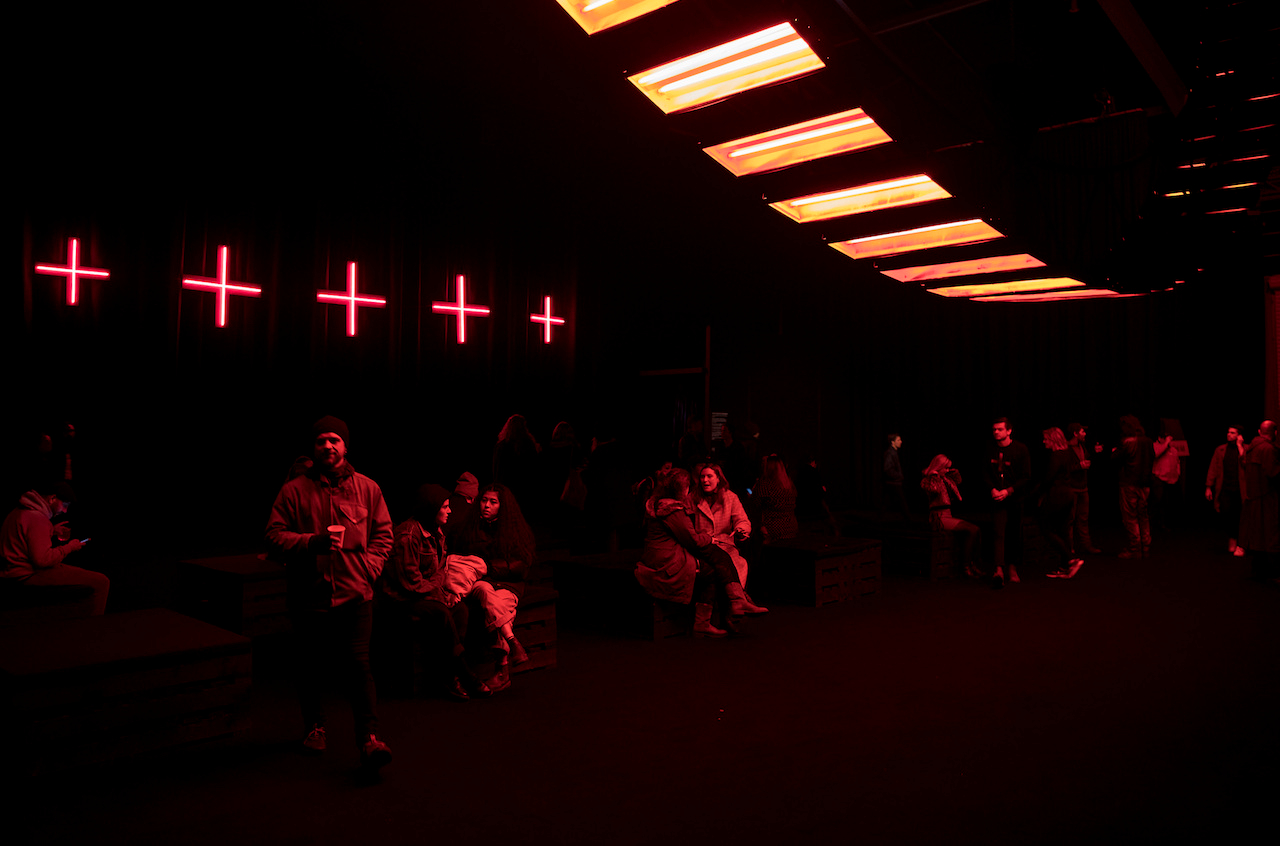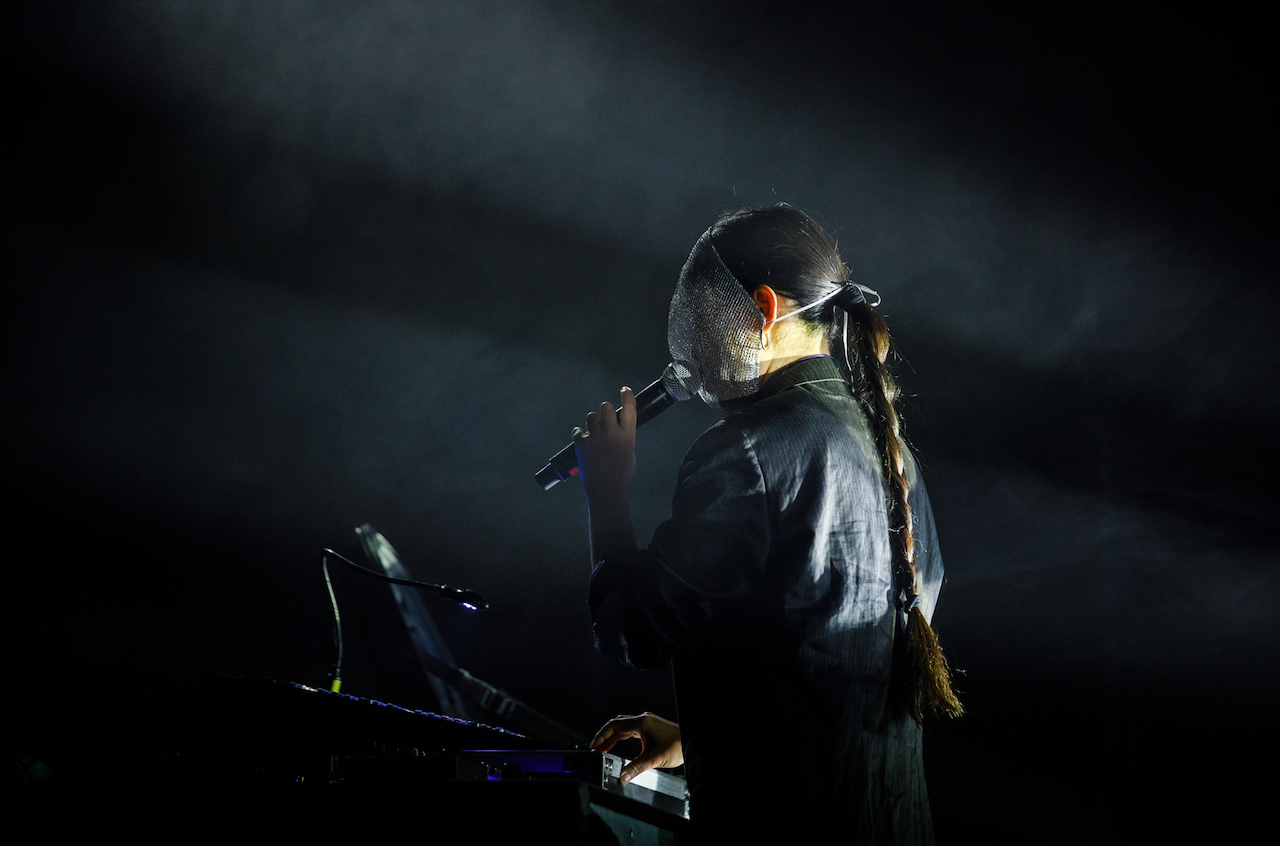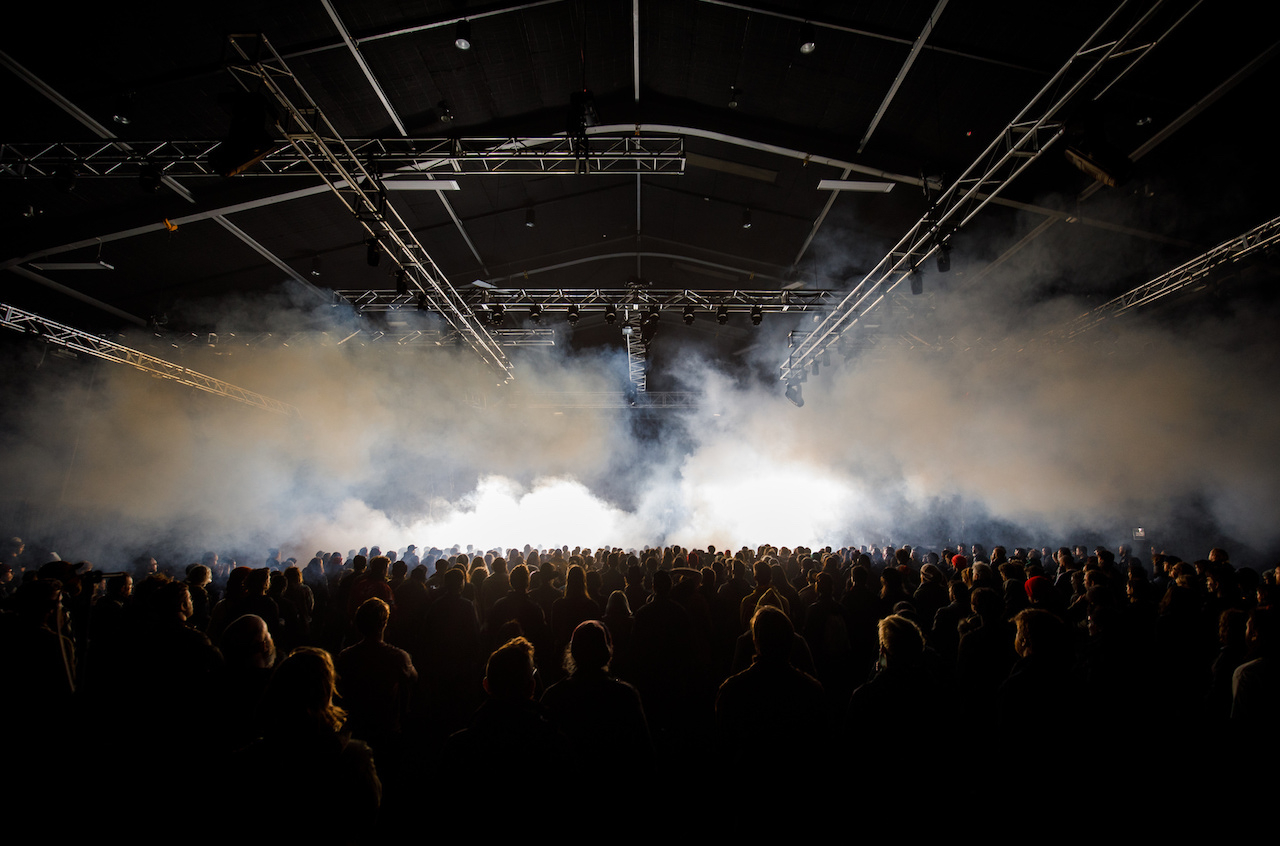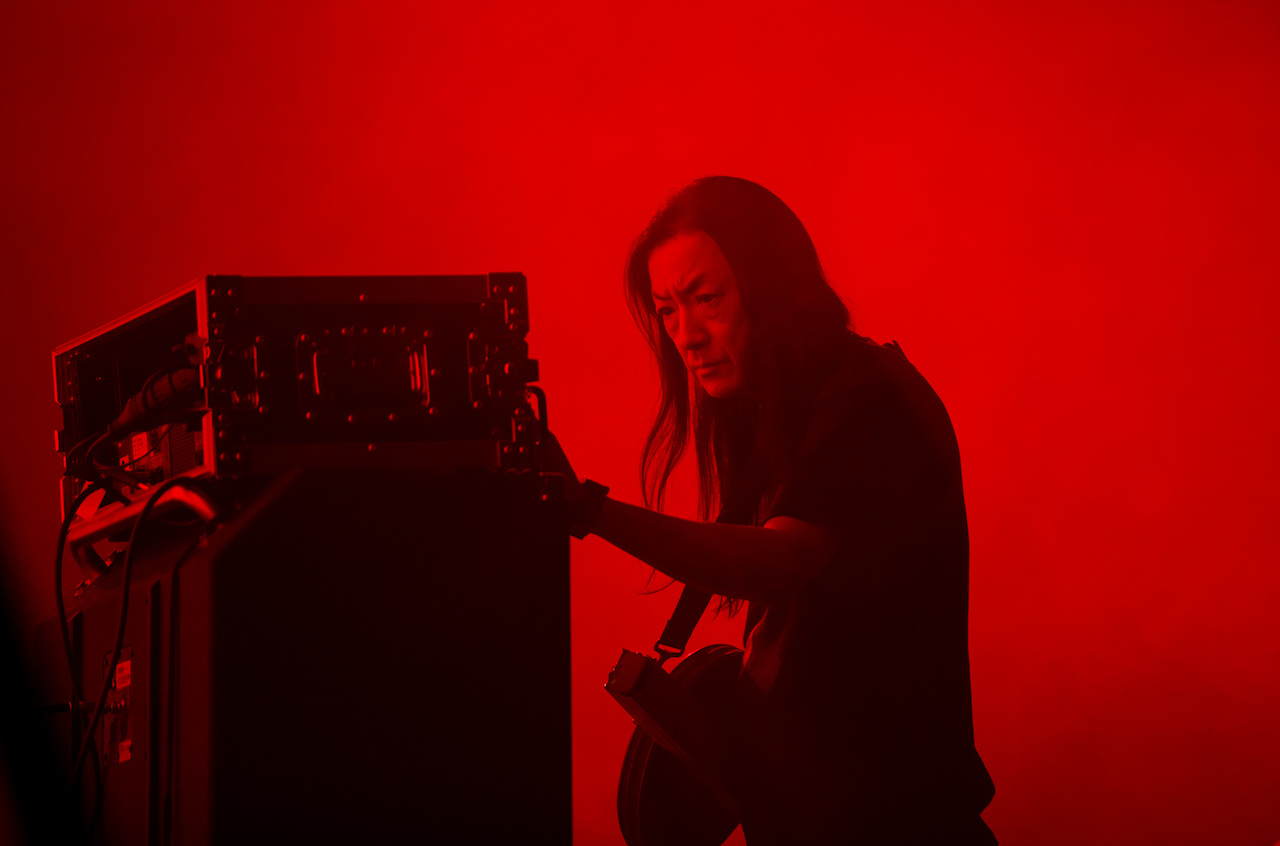- This subversive arts and music festival continues to challenge its audience.
- Glistening red across Hobart's waterfront stood the controversial upside-down crosses. 20-metres tall and spread throughout the city, they were the focus of media attention in the lead-up to the sixth edition of Dark Mofo, a contemporary arts and music festival timed with the southern winter solstice. Long considered an unremarkable backwater in Australia, Hobart has an undeniable pull these days, thanks in part to the opening of the Museum Of New And Old Art (AKA MONA), funded by the eccentric millionaire gambler and art collector David Walsh. The museum is behind Dark Mofo, which is a winter version of its summer festival, MONA FOMA. "We are a festival that resists the centre," said Walsh of the complaints about the crucifixes.
Darkness is the prevailing theme of Dark Mofo. Its programming verges on the subversive, a key selling point for the roughly 15,000 tourists who venture down each year. Audiences expect to be challenged, and although it keeps growing, the festival doesn't compromise. The focus is visual art, though music plays an increasingly central role.
Dark Mofo 2018 ran from June 13th through 24th, and on the last weekend, the experimental music festival Berlin Atonal curated two nights, called Laterne, at Mac2, a large wharf space on Hobart's foreshore. The second night, which took place on a Friday, opened with the ambient trips of the Melbourne producer Rings Around Saturn. After a weary day of pounding the pavement, I joined the majority of the crowd in sitting on the floor, staying that way through sets from Iona Fortune and Drew McDowall.
That same night, the premiere of FIS and Pyur's new project, 7 Blue Stones, proved memorable. Performing in a blue-tinged room, the duo writhed between haunting melancholia, orchestral reverberations and near-euphoric synths. Light was strictly forbidden for the next act, Autechre, who performed in pitch-black for the duration of their one-hour set. Most people took the rare opportunity to get lost in the UK duo's discordant sound, but it was hard to ignore the restlessness and chatter in sections of crowd. (Later that night, a friend told me that he heard someone in the toilets complaining that Laterne was more ambient than they had expected.)
On Saturday, at an event titled Borderlands, Pan Daijing mentioned her frustration with the Autechre audience during the prologue of her set. "I don't want that to happen to me while I'm playing, because you should be talking to me, while I'm here talking to you. You can talk after," she told the crowd. Borderlands also took place at Mac2, and the night featured another bill stacked with artists who push music to its limits. William Basinski drew loud applause when he took the stage, only to then implore everyone to sit back down. "I'm not going to do air guitar or anything," he joked.
A last-minute cancellation by The Haxan Cloak meant Roly Porter and the visual artist MFO stepped in with their audiovisual live show. They delivered a thrilling performance. At the end, the crowd were asked to close their eyes as strobe lights and thunderous roars combined for an hallucinogenic experience. If that assault of noise wasn't enough, there was the Japanese experimental pioneer Merzbow. The sheer brutality of his sound made sense on the venue's heavyweight soundsystem, the vibrations ebbing and flowing throughout the space. While a crowd gathered at the front, others decided to curl up or bow their heads to absorb the intensity of it all.
It was after these events, which finished at midnight, that Dark Mofo's recent expansion revealed some growing pains. Night Mass, the festival's late-night program featuring Vril, Rroxymore and Demdike Stare, sold out, but still there were a flurry of people looking for tickets. Otherwise, your options were limited to a few local bars.
After leaving Tasmania, news surfaced about the future of Dark Mofo. Despite its success, it had come under political scrutiny due to concerns it was creating an "unhealthy culture" in the city. But the organisers won't budge. "If we acquiesce to curatorial influence and become tame, the festival will die in three years, so the money will be irrelevant," said Walsh. He's right—the distinct quality of Dark Mofo is that its audience wants to be challenged. To lose that would be a great shame.
Photo credit /
MONA/Dark Mofo Rémi Chauvin - Lead, Laterne
Dark Mofo/Jesse Hunniford - Pan Daijing, Crowd, Merzbow
 That same night, the premiere of FIS and Pyur's new project, 7 Blue Stones, proved memorable. Performing in a blue-tinged room, the duo writhed between haunting melancholia, orchestral reverberations and near-euphoric synths. Light was strictly forbidden for the next act, Autechre, who performed in pitch-black for the duration of their one-hour set. Most people took the rare opportunity to get lost in the UK duo's discordant sound, but it was hard to ignore the restlessness and chatter in sections of crowd. (Later that night, a friend told me that he heard someone in the toilets complaining that Laterne was more ambient than they had expected.) On Saturday, at an event titled Borderlands, Pan Daijing mentioned her frustration with the Autechre audience during the prologue of her set. "I don't want that to happen to me while I'm playing, because you should be talking to me, while I'm here talking to you. You can talk after," she told the crowd. Borderlands also took place at Mac2, and the night featured another bill stacked with artists who push music to its limits. William Basinski drew loud applause when he took the stage, only to then implore everyone to sit back down. "I'm not going to do air guitar or anything," he joked.
That same night, the premiere of FIS and Pyur's new project, 7 Blue Stones, proved memorable. Performing in a blue-tinged room, the duo writhed between haunting melancholia, orchestral reverberations and near-euphoric synths. Light was strictly forbidden for the next act, Autechre, who performed in pitch-black for the duration of their one-hour set. Most people took the rare opportunity to get lost in the UK duo's discordant sound, but it was hard to ignore the restlessness and chatter in sections of crowd. (Later that night, a friend told me that he heard someone in the toilets complaining that Laterne was more ambient than they had expected.) On Saturday, at an event titled Borderlands, Pan Daijing mentioned her frustration with the Autechre audience during the prologue of her set. "I don't want that to happen to me while I'm playing, because you should be talking to me, while I'm here talking to you. You can talk after," she told the crowd. Borderlands also took place at Mac2, and the night featured another bill stacked with artists who push music to its limits. William Basinski drew loud applause when he took the stage, only to then implore everyone to sit back down. "I'm not going to do air guitar or anything," he joked.
 A last-minute cancellation by The Haxan Cloak meant Roly Porter and the visual artist MFO stepped in with their audiovisual live show. They delivered a thrilling performance. At the end, the crowd were asked to close their eyes as strobe lights and thunderous roars combined for an hallucinogenic experience. If that assault of noise wasn't enough, there was the Japanese experimental pioneer Merzbow. The sheer brutality of his sound made sense on the venue's heavyweight soundsystem, the vibrations ebbing and flowing throughout the space. While a crowd gathered at the front, others decided to curl up or bow their heads to absorb the intensity of it all. It was after these events, which finished at midnight, that Dark Mofo's recent expansion revealed some growing pains. Night Mass, the festival's late-night program featuring Vril, Rroxymore and Demdike Stare, sold out, but still there were a flurry of people looking for tickets. Otherwise, your options were limited to a few local bars. After leaving Tasmania, news surfaced about the future of Dark Mofo. Despite its success, it had come under political scrutiny due to concerns it was creating an "unhealthy culture" in the city. But the organisers won't budge. "If we acquiesce to curatorial influence and become tame, the festival will die in three years, so the money will be irrelevant," said Walsh. He's right—the distinct quality of Dark Mofo is that its audience wants to be challenged. To lose that would be a great shame. Photo credit / MONA/Dark Mofo Rémi Chauvin - Lead, Laterne Dark Mofo/Jesse Hunniford - Pan Daijing, Crowd, Merzbow
A last-minute cancellation by The Haxan Cloak meant Roly Porter and the visual artist MFO stepped in with their audiovisual live show. They delivered a thrilling performance. At the end, the crowd were asked to close their eyes as strobe lights and thunderous roars combined for an hallucinogenic experience. If that assault of noise wasn't enough, there was the Japanese experimental pioneer Merzbow. The sheer brutality of his sound made sense on the venue's heavyweight soundsystem, the vibrations ebbing and flowing throughout the space. While a crowd gathered at the front, others decided to curl up or bow their heads to absorb the intensity of it all. It was after these events, which finished at midnight, that Dark Mofo's recent expansion revealed some growing pains. Night Mass, the festival's late-night program featuring Vril, Rroxymore and Demdike Stare, sold out, but still there were a flurry of people looking for tickets. Otherwise, your options were limited to a few local bars. After leaving Tasmania, news surfaced about the future of Dark Mofo. Despite its success, it had come under political scrutiny due to concerns it was creating an "unhealthy culture" in the city. But the organisers won't budge. "If we acquiesce to curatorial influence and become tame, the festival will die in three years, so the money will be irrelevant," said Walsh. He's right—the distinct quality of Dark Mofo is that its audience wants to be challenged. To lose that would be a great shame. Photo credit / MONA/Dark Mofo Rémi Chauvin - Lead, Laterne Dark Mofo/Jesse Hunniford - Pan Daijing, Crowd, Merzbow